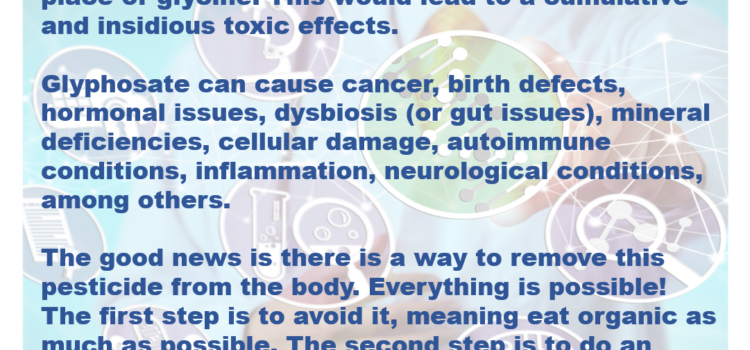It is becoming increasingly clear the glyphosate or Roundup is highly toxic.
To date, there are about 8,000 lawsuits against Monsanto, now a subsidiary of Bayer, over the alleged health risks from exposure to glyphosate. The decade’s long orchestration to downplay the health risks of glyphosate in the food supply is losing its grip. People are beginning to question the painted image of glyphosate as a benign, environment-friendly, and non-toxic herbicide. The truth is unraveling!
Below are some mechanisms of glyphosate toxicity:
- Glyphosate mimics glycine – one of the 21 amino acids that constitute the building blocks of all life forms. Insidiously, glyphosate “pretending” to be a glycine inserts itself in the amino acid chains. As glyphosate takes over the places intended for glycine, this synthetic compound has the ability to disrupt the functioning of the protein and cause genetic mutations. You can read more about this by reading this scientific article:
“On the degradation pathway of glyphosate and glycine”
https://pubs.rsc.org/en/content/articlelanding/2018/em/c8em00119g#!divAbstract
- Damaged proteins carrying glyphosates stay in the body as residues that build up over time. The accumulation of glyphosate within the body, therefore, causes enzymes to fail. As glyphosate-carrying proteins spread, the body becomes susceptible to a host of chronic diseases. These include neurological (Alzheimer’s disease, Parkinson’s, Creutzfeld-Jacob disease, Moton Neuron disease) to metabolic diseases and digestive diseases, (diabetes, obesity, adrenal insufficiency, hypothyroidism) to autoimmune disorders (lupus, mitochondrial disease, non-Hodgkin’s lymphoma, celiac disease)
- Exposure to glyphosate increases cancer risk by 41%. A study conducted by the University of Washington upholds the assertion that glyphosate has carcinogenic effects on humans. This study, therefore, corroborates the lawsuit filed by Dewayne Johnson. Johnson got a non-Hodgkin’s lymphoma diagnosis in 2014. The jury sided with Johnson to the tune of $289 million in punitive damages.
- Glyphosate in food is linked to pregnancy problems. Researchers at Children’s Environmental Health Network (CEHN) are looking at the correlation of pregnant mothers’ exposure to glyphosate. They’re looking at unfavorable birth outcomes as well. Their findings indicate that mothers with higher glyphosate levels in their urine show shorter pregnancy length and lower birth rate of their babies.
- Glyphosate is an antibiotic masquerading as an herbicide. Hence, ingesting glyphosate in food upsets the gut microbiota. Glyphosate works by inhibiting the Shikimate Pathway – a series of metabolic steps present in plants, fungi, protozoa, and bacteria, to produce aromatic amino acids (phenylalanine, tyrosine, and tryptophan). Advocates claim that glyphosate is not harmful to humans as the Shikimate Pathway does not occur in humans and animals. But the truth is glyphosate in food enters our gut and primarily targets the good bacteria. Toxicity sets in as harmful bacteria and pathogens outnumber the good guys.
Interestingly, glyphosate might play a critical role in the coronavirus epidemic!
This is a very interesting article to read:
“Connecting the Dots: Glyphosate and COVID-19”
https://jennifermargulis.net/glyphosate-and-covid-19-connection/
It is a very long article, so I will summarize the main points.
“The pandemic that we have long been told is coming any day now has unfortunately arrived. A new strain of coronavirus named SARS-CoV-2, causing the new disease called COVID-19, has taken the world by storm, practically shutting down the global economy and overwhelming hospital systems.”
“Coronaviruses are the cause of the common cold, a nuisance for sure, but usually not considered dangerous. Somehow this one is different. It seems to ferociously attack the lungs, causing the immune system to launch a so-called “cytokine storm,” an exaggerated response by the immune system to an infection that can lead to collateral damage to the lung tissues.”
“The human immune system consists of an “innate” component that is always active and normally very competent to clear most infections that come along and an “adaptive” component which is a second-line defense system called into play when the innate system is overwhelmed.
The innate component produces a number of different specialized proteins that can hunt down and trap viruses, delivering them to macrophages for clearance.
The adaptive immune system has basically two branches, one of which produces a “cytokine storm” in an attempt to “shoot” the rapidly proliferating viruses with toxic molecules. The other branch produces antibodies that are specific to the infective agent, but this can lead to autoimmune disease down the road through a process called molecular mimicry.
If the innate immune system is broken, the adaptive system goes into overdrive. When this happens there can be sufficient collateral damage to ultimately kill the host.”
Chronic obstructive pulmonary disease (COPD) is the third leading cause of death worldwide. While smoking is the primary risk factor for COPD, farmers and agricultural workers are known to have an increased risk of lung disease.
A population-based study published in 2017 showed that occupational exposure to herbicides was associated with more than a 2-fold increased risk of COPD.
A 2020 paper, published in the Lancet, “COVID-19: consider cytokine storm syndromes and immunosuppression,” claims that “respiratory failure from acute respiratory distress syndrome (ARDS) is the leading cause of mortality” in COVID-19 infection.
Other research helps connect the dots: This cleverly designed study by Kumar et al., published in 2014, involved collecting air samples from farms during glyphosate application and exposing a group of mice to these samples.
The authors noted that glyphosate exposure stimulated airway inflammation and promoted asthma-related cytokines. They summarized as follows:
Collectively, our results showed that mice continuously exposed to glyphosate developed elevated levels of eosinophils, neutrophils, and asthma-related cytokines (IL-5, IL-10, IL-13, IL-33, TSLP) compared to control groups. Exposure to glyphosate results in airway barrier damage.”
Researchers from Wuhan, China have done a careful study of four patients who suffered from an acute reaction to COVID-19 and ultimately died. These patients all had severe issues with insufficient oxygen supply due to pneumonia. They also exhibited deficiencies in immune function in terms of decreased counts of various types of immune cells.
Notably, they all suffered from gut dysbiosis, with under-representation of Bifidobacteria and Lactobacillus, and disproportionate overrepresentation of pathogens such as Corynebacterium and Ruthenibacterium. They also had a fungus infection with an overgrowth of Aspergillus. This pattern of gut dysbiosis is in accord with what my colleagues and I have observed in association with glyphosate exposure in animal studies.
The degree to which a person is susceptible to COVID-19 is proportional to the degree to which they have been exposed to glyphosate. Eating a certified organic diet and staying away from major highways may be among the best tools for protection from an acute reaction to COVID-19.
Bhutan is a landlocked country in the eastern Himalayas, bordered by Tibet and India. The population of Bhutan is a little over 807,000 people.
As of this writing in early April 2020, only four cases of COVID-19 have been reported for Bhutan, two of whom were visiting foreigners.
Bhutan has embraced the ambitious goal of becoming the world’s first 100% organic nation. Is it possible that there is so little COVID-19 because Bhutan’s people aren’t being over-exposed to glyphosate?
Glyphosate and COVID-19: putting it all together.
The United States has stood out as the country hit the hardest by COVID-19. We also consume more glyphosate per capita than any other country in the world. It will be a tragic irony if it turns out that our attempts to reduce carbon emissions through the use of extracts from glyphosate-exposed food crops and trees as a source of fuel in cars, trucks, buses, ships, airplanes, and as heating oil for buildings, turn out to be one of the primary causes of the COVID-19 epidemic.
God bless y’all 😊
Dr. Serge




